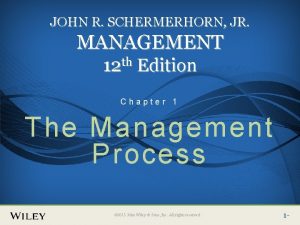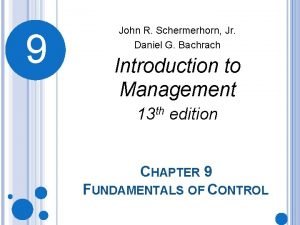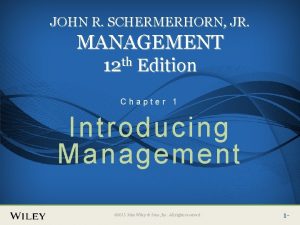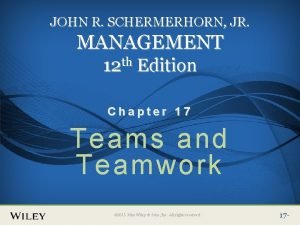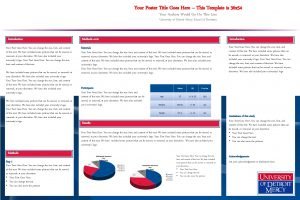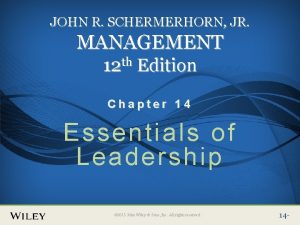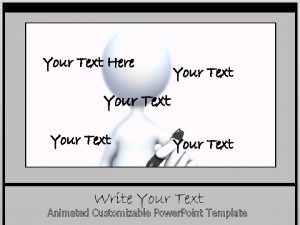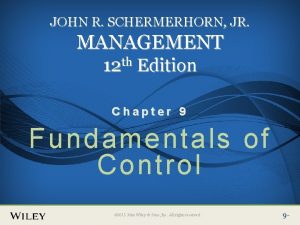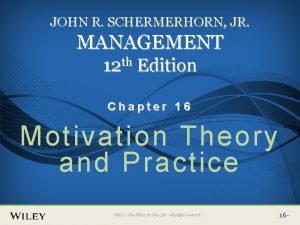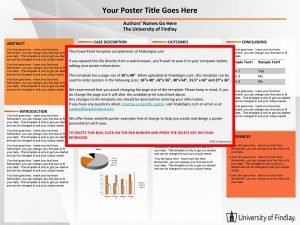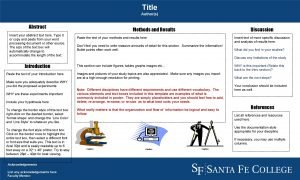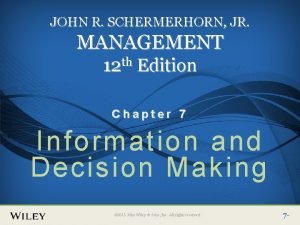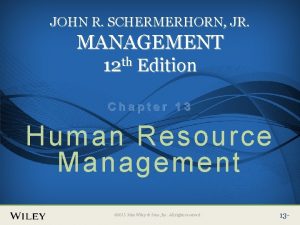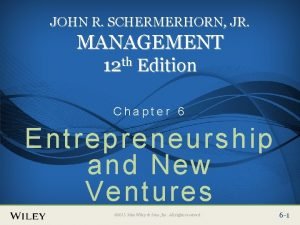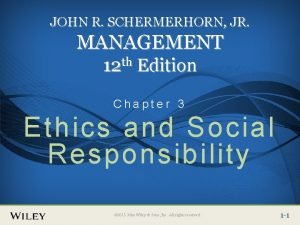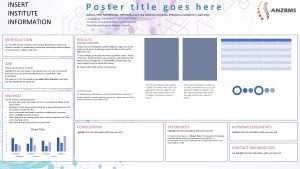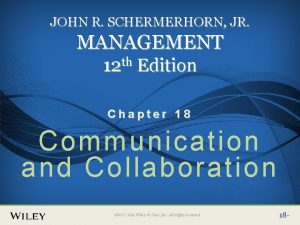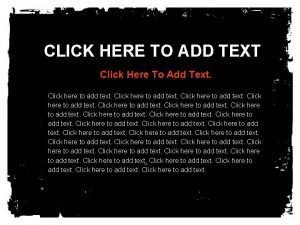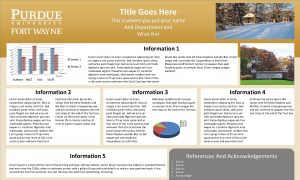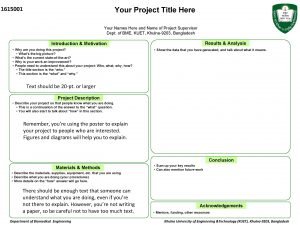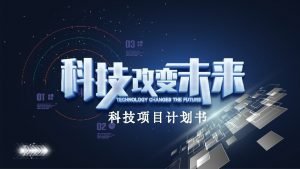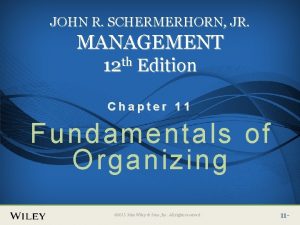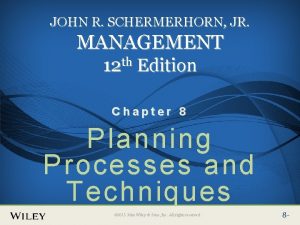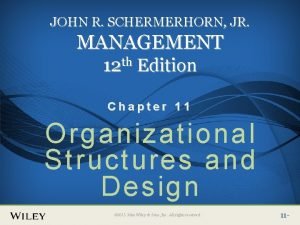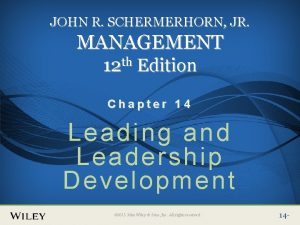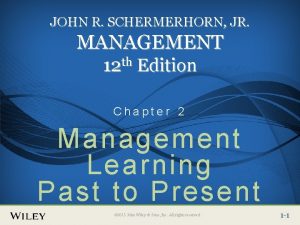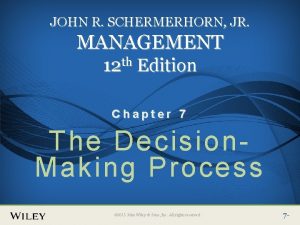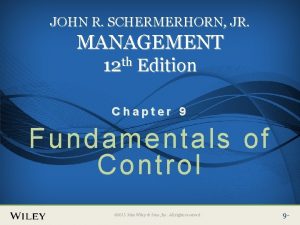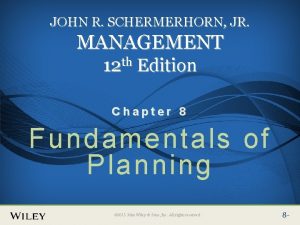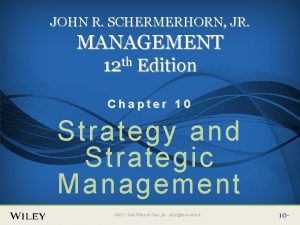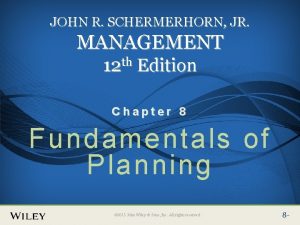Place Slide Title Text Here JOHN R SCHERMERHORN









































- Slides: 41

Place Slide Title Text Here JOHN R. SCHERMERHORN, JR. MANAGEMENT 12 th Edition Chapter 7 Information and Decision Making © 2013 John Wiley & Sons, Inc. All rights reserved. 7 -

Planning Ahead — Chapter Place Slide Title Text Here 7 Study Questions 1. What is the role of information in the management process? 2. How do managers use information to make decisions? 3. What are the steps in the decision-making process? 4. What are the current issues in managerial decision making? © 2013 John Wiley & Sons, Inc. All rights reserved. 7 -2

Chapter 7 Learning Place Slide Title Text Here Dashboard 1. Information, Technology, and Management 1. 2. 3. 4. What is useful information? Information systems and business intelligence Information needs in organizations How information technology is changing organizations 2. Information and Managerial Decisions 1. 2. 3. 4. Managers as information processors Managers as problem solvers Types of managerial decisions Decision conditions © 2013 John Wiley & Sons, Inc. All rights reserved. 7 -3

Chapter 7 Learning Place Slide Title Text Here Dashboard 3. The Decision-Making Process 1. 2. 3. 4. 5. 6. Step 1 – Identify and Define the Problem Step 2 – Generate and Evaluate Alternative Courses of Action Step 3 – Decide on a Preferred Course of Action Step 4 – Implement the Decision Step 5 – Evaluate Results At All Steps – Check Ethical Reasoning 4. Issues in Managerial Decision Making 1. 2. Decision errors and traps Creativity in decision making © 2013 John Wiley & Sons, Inc. All rights reserved. 7 -4

Takeaway 1: Information, Technology, & Management Place Slide Title Text Here Information, Technology, & Management – Managers must have • Technological competency – Ability to understand new technologies and to use them to their best advantage • Information competency – Ability to locate, gather, organize, and display information for decision making and problem solving • Analytical competency – Ability to evaluate and analyze information to make actual decisions and solve real problems © 2013 John Wiley & Sons, Inc. All rights reserved. 7 -5

Takeaway Information, Technology, & Management Place Slide 1: Title Text Here What is useful information? – Data • Raw facts and observations – Information • Data made useful and meaningful for decision making – Information drives management functions © 2013 John Wiley & Sons, Inc. All rights reserved. 7 -6

Takeaway Information, Technology, & Management Place Slide 1: Title Text Here • Characteristics of useful information: – Timely – High quality – Complete – Relevant – Understandable • Analytics: systematic gathering and processing of data to make it useful as information © 2013 John Wiley & Sons, Inc. All rights reserved. 7 -7

Takeaway Information, Technology, & Management Place Slide 1: Title Text Here Information systems and business intelligence – Management information systems • Use IT to collect, organize, and distribute data for use in decision making – Business intelligence • Taps information systems to extract and report data in organized ways that are helpful to decision makers © 2013 John Wiley & Sons, Inc. All rights reserved. 7 -8

Takeaway Information, Technology, & Management Place Slide 1: Title Text Here Executive dashboards • Visually update and display key performance indicators and information on a real-time basis © 2013 John Wiley & Sons, Inc. All rights reserved. 7 -9

Takeaway Information, Technology, & Management Place Slide 1: Title Text Here Information needs in organizations – Information exchanges with the external environment: • Gather intelligence information • Provide public information – Information exchanges within the organization: • Facilitate decision making • Facilitate problem solving © 2013 John Wiley & Sons, Inc. All rights reserved. 7 -10

Takeaway 1: Information, Technology, & Management Place Slide Title Text Here Implications of IT for relationships with external environment: • Helps with customer relationship management • Helps organizations with supply chain management • Helps in monitoring outsourcing and other business contracts Implications of IT within organizations: • Facilitation of communication and information sharing • Operating with fewer middle managers • Flattening of organizational structures • Faster decision making • Increased coordination and control © 2013 John Wiley & Sons, Inc. All rights reserved. 7 -11

Place Slide Title Text Here Figure 7. 1 Internal and external information needs in organizations © 2013 John Wiley & Sons, Inc. All rights reserved. 7 -12

Place Slide Title Text Here Figure 7. 2 Information technology is breaking barriers and changing organizations © 2013 John Wiley & Sons, Inc. All rights reserved. 7 -13

Takeaway 2: Information and Managerial Decisions Place Slide Title Text Here Information and Managerial Decisions – Managers as Information Processors • Continually gather, give, and receive information • Now as much electronic as it is face to face • Always on, always connected © 2013 John Wiley & Sons, Inc. All rights reserved. 7 -14

Place Slide Title Text Here Figure 7. 3 The manager as an informationprocessing nerve center © 2013 John Wiley & Sons, Inc. All rights reserved. 7 -15

Takeaway 2: Information and Managerial Decisions Place Slide Title Text Here Problem solving – The process of identifying a discrepancy between actual and desired performance and taking action to resolve it Decision Performance threat Performance opportunity A choice among possible alternative courses of action Something is wrong or has the potential to go wrong Situation offers the chance for a better future if the right steps are taken © 2013 John Wiley & Sons, Inc. All rights reserved. 7 -16

Takeaway 2: Information and Managerial Decisions Place Slide Title Text Here Problem-solving approaches or styles: Problem avoiders Problem solvers Problem seekers • Inactive in information gathering and solving problems • Reactive in gathering information and solving problems • Proactive in anticipating problems and opportunities and taking appropriate action to gain an advantage © 2013 John Wiley & Sons, Inc. All rights reserved. 7 -17

Takeaway 2: Information and Managerial Decisions Place Slide Title Text Here Systematic versus intuitive thinking Systematic thinking Intuitive thinking • approaches problems in a rational, step-bystep, and analytical fashion • approaches problems in a flexible and spontaneous fashion © 2013 John Wiley & Sons, Inc. All rights reserved. 7 -18

Takeaway 2: Information and Managerial Decisions Place Slide Title Text Here Multidimensional thinking applies both intuitive and systematic thinking – Effective multidimensional thinking requires skill at strategic opportunism © 2013 John Wiley & Sons, Inc. All rights reserved. 7 -19

Takeaway 2: Information and Managerial Decisions Place Slide Title Text Here Managers use different cognitive styles © 2013 John Wiley & Sons, Inc. All rights reserved. 7 -20

Takeaway 2: Information and Managerial Decisions Place Slide Title Text Here Types of problems – Structured problems are ones that are familiar, straightforward, and clear with respect to information needs – Programmed decisions apply solutions that are readily available from past experiences to solve structured problems © 2013 John Wiley & Sons, Inc. All rights reserved. 7 -21

Takeaway 2: Information and Managerial Decisions Place Slide Title Text Here Types of problems – Unstructured problems are ones that are full of ambiguities and information deficiencies – Nonprogrammed decisions apply a specific solution to meet the demands of a unique problem – Commonly faced by higher-level management © 2013 John Wiley & Sons, Inc. All rights reserved. 7 -22

Takeaway 2: Information and Managerial Decisions Place Slide Title Text Here Crisis decision making – A crisis involves an unexpected problem that can lead to disaster if not resolved quickly and appropriately © 2013 John Wiley & Sons, Inc. All rights reserved. 7 -23

Takeaway 2: Information and Managerial Decisions Place Slide Title Text Here Rules for crisis management: • Figure out what is going on • Remember that speed matters • Remember that slow counts, too • Respect the danger of the unfamiliar • Value the skeptic • Be ready to “fight fire with fire ” © 2013 John Wiley & Sons, Inc. All rights reserved. 7 -24

Takeaway 2: Information and Managerial Decisions Place Slide Title Text Here Managers make decisions with various amounts of information Certain environment • offers complete information on possible action alternatives and their consequences Risk environment • lacks complete information but offers probabilities of the likely outcomes for possible action alternatives Uncertain environment • lacks so much information that it is difficult to assign probabilities to the likely outcomes of alternatives © 2013 John Wiley & Sons, Inc. All rights reserved. 7 -25

Place Slide Title Text Here Figure 7. 4 Three environments for managerial decision making and problem solving © 2013 John Wiley & Sons, Inc. All rights reserved. 7 -26

Place Slide Title Text Here Figure 7. 5 Steps in managerial decision making and problem solving © 2013 John Wiley & Sons, Inc. All rights reserved. 7 -27

Takeaway 3 : The Process Place Slide Title Text. Decision-Making Here Step 1 — Identify and define the problem – Focuses on information gathering, information processing, and deliberation – Decision objectives should be established – Common mistakes in defining problems: • Defining the problem too broadly or too narrowly • Focusing on symptoms instead of causes • Choosing the wrong problem © 2013 John Wiley & Sons, Inc. All rights reserved. 7 -28

Takeaway 3 : The Process Place Slide Title Text. Decision-Making Here Step 2 — Generate and Evaluate Alternative Courses of Action – Potential solutions are formulated and more information is gathered, data are analyzed, the advantages and disadvantages of alternative solutions are identified – Approaches for evaluating alternatives: • Stakeholder analysis • Cost-benefit analysis © 2013 John Wiley & Sons, Inc. All rights reserved. 7 -29

Takeaway 3 : The Process Place Slide Title Text. Decision-Making Here Step 2 — Generate and Evaluate Possible Courses of Action (cont. ) – Criteria for evaluating alternatives: • • • Benefits Costs Timeliness Acceptability Ethical soundness © 2013 John Wiley & Sons, Inc. All rights reserved. 7 -30

Takeaway 3 : The Process Place Slide Title Text. Decision-Making Here Step 2 — Generate and Evaluate Possible Courses of Action (cont. ) – Common mistakes: • Abandoning the search for alternatives too quickly © 2013 John Wiley & Sons, Inc. All rights reserved. 7 -31

Takeaway 3 : The Process Place Slide Title Text. Decision-Making Here Step 3 — Decide on a Preferred Course of Action – Two different approaches • Behavioral model leads to satisficing decisions • Classical model leads to optimizing decisions © 2013 John Wiley & Sons, Inc. All rights reserved. 7 -32

Place Slide Title Text Here Figure 7. 6 Differences in the classical and behavioral decision-making models © 2013 John Wiley & Sons, Inc. All rights reserved. 7 -33

Takeaway 3 : The Process Place Slide Title Text. Decision-Making Here Step 4 — Implement the Decision – Involves taking action to make sure the solution decided upon becomes a reality – Managers need to have willingness and ability to implement action plans – Lack-of-participation error should be avoided © 2013 John Wiley & Sons, Inc. All rights reserved. 7 -34

Takeaway 3 : The Process Place Slide Title Text. Decision-Making Here Step 5 — Evaluate Results – Involves comparing actual and desired results – Positive and negative consequences of chosen course of action should be examined – If actual results fall short of desired results, the manager returns to earlier steps in the decisionmaking process © 2013 John Wiley & Sons, Inc. All rights reserved. 7 -35

Takeaway 3 : The Process Place Slide Title Text. Decision-Making Here At all steps, check ethical reasoning! – Ask these spotlight questions Utility • Does the decision satisfy all constituents or stakeholders? Rights • Does the decision respect the rights and duties of everyone? Justice • Is the decision consistent with the canons of justice? Caring • Is the decision consistent with my responsibilities to care? © 2013 John Wiley & Sons, Inc. All rights reserved. 7 -36

Takeaway 4: Issues in Managerial Decision Making Place Slide Title Text Here Issues in decision making – How do decision errors happen? – Heuristics are strategies for simplifying decision making © 2013 John Wiley & Sons, Inc. All rights reserved. 7 -37

Takeaway 4: Issues in Managerial Decision Making Place Slide Title Text Here Availability Bias • Bases a decision on recent information or events Representativeness Bias • Bases a decision on similarity to other situations Anchoring and Adjustment Bias • Bases a decision on incremental adjustment from a prior decision point Framing Error • Trying to solve a problem in the context in a positive or negative context Confirmation Error • Focusing on information that confirms a decision already made Escalating Commitment • Continuing a course of action even though it is not working © 2013 John Wiley & Sons, Inc. All rights reserved. 7 -38

Takeaway 4: Issues in Managerial Decision Making Place Slide Title Text Here Creative Decision making: – Creativity is the generation of a novel idea or unique approach that solves a problem or crafts an opportunity • Big-C creativity occurs when extraordinary things are done by exceptional people • Little-C creativity occurs when average people come up with unique ways to deal with daily events and situations © 2013 John Wiley & Sons, Inc. All rights reserved. 7 -39

Takeaway 4: Issues in Managerial Decision Making Place Slide Title Text Here Personal creativity drivers Task Motivation Task Expertise Creativity Skills Creativity © 2013 John Wiley & Sons, Inc. All rights reserved. 7 -40

Takeaway 4: Issues in Managerial Decision Making Place Slide Title Text Here Situational creativity drivers Management Support Team Creativity Skills Organizational Culture Creativity © 2013 John Wiley & Sons, Inc. All rights reserved. 7 -41
 John r. schermerhorn jr. management
John r. schermerhorn jr. management Measuring the actual performance
Measuring the actual performance John r. schermerhorn jr. management
John r. schermerhorn jr. management Text to text text to self text to world
Text to text text to self text to world Toe and heel dance
Toe and heel dance Title text goes here
Title text goes here Text goes here
Text goes here Title text here
Title text here Title text goes here
Title text goes here Title text here
Title text here Title text here
Title text here Your title here
Your title here ℰ??ℳ?ℒℰ, ???ℛ ?ℰ?? ℋℰℛℰ
ℰ??ℳ?ℒℰ, ???ℛ ?ℰ?? ℋℰℛℰ Your text goes here
Your text goes here Title text here
Title text here Title text here
Title text here Title text here
Title text here Title text here
Title text here Title text goes here
Title text goes here Title text here
Title text here Title text here
Title text here Title text here
Title text here Title text here
Title text here Title text here
Title text here Title text here
Title text here Title text goes here
Title text goes here Your text goes here
Your text goes here I subtitle
I subtitle Title text here
Title text here Title text here
Title text here Slide todoc.com
Slide todoc.com Organizational behavior schermerhorn
Organizational behavior schermerhorn There's a place where streams of grace
There's a place where streams of grace Your title goes here
Your title goes here Add your title here
Add your title here Add your title here
Add your title here Your title here
Your title here Title goes here significado
Title goes here significado Your title here
Your title here Project title names
Project title names Your title here
Your title here Logo subtitle
Logo subtitle
